The Complete Guide to Bryce Canyon National Park, From Hikes and Hoodoos to Heavenly Stargazing
Hiding like a parallel universe on a high plateau called the Grand Staircase, Bryce Canyon National Park is unlike any place you've seen. Its vast red-, orange-, and pink-hued expanse of wildly eroded spires contains the largest concentration of hoodoos—irregular, intricately carved columns of rock—on Earth. It’s a top-down park, where you arrive up high and hike (or ride horseback) down into its maze of spires, passageways, and arches before either making your way back exactly the way you came to the rim—or looping into countless other trails (mindfully). Bryce is a labyrinth not to be underestimated.
You can visit Bryce Canyon during a week-long spin through southern Utah, hitting four of the country's most spectacular national parks in one shot. Given that Zion National Park, Bryce Canyon National Park, Capitol Reef National Park, and Grand Staircase-Escalante National Monument are all within about 200 miles of each other, why not? (And it’s not like the drive between them is shabby, either, from the towering gates of the Zion Narrows to the hoodoos of Bryce, slots of Escalante, and canyons of Capitol Reef.)
Here's your primer to Bryce Canyon National Park.
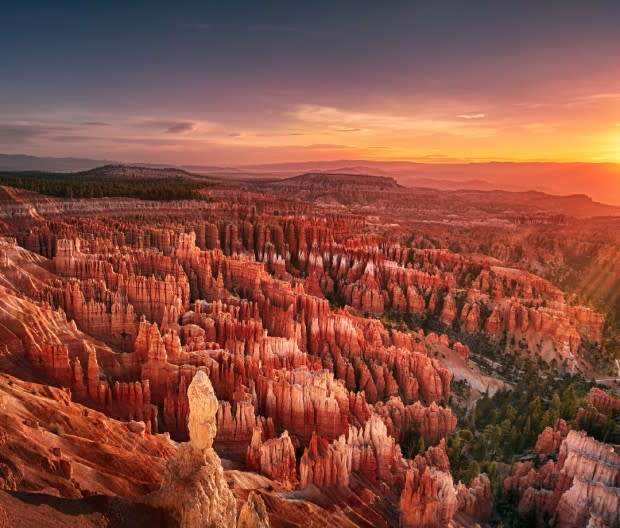
Getty Images/LordRunar
Where Is Bryce Canyon National Park
Situated 80 miles northeast of Zion National Park in a markedly different climatic and geological zone than its quasi-neighbor, Bryce Canyon National Park is perched at an elevation of 8,000 feet on southern Utah's Paunsagunt Plateau—descending into a dramatic fault line of sedimentary rock running about 20-miles long (north to south) and, at most, five miles wide.
The nearest town, Bryce Canyon City (pop. 195), is a couple miles north of the park on Utah State Route 63—a short road linking the park to State Route 12 and other nearby towns, including Cannonvile, Panguitch, and Hatch. The closest major cities to Bryce are Las Vegas and Salt City, both about 260 miles away from opposite ends.
Related: Unique Ways to Explore National Parks Like Never Before
Bryce Canyon National Park Weather: Best Time to Visit
At its 8,000-plus-foot elevation, Bryce can be significantly cooler than Zion (a full 1,000 feet lower) and other southern Utah parks, so it’s a good idea to be equipped with warm layers here even in the warmest months. Summer is by far the most popular time to visit, with comfortable daytime temperatures—and common thundershowers from mid-to-late season. Temperatures in the pleasantly less-crowded spring and fall are variable during the day and reliably brisk after sundown. Winters can be downright frigid here, plummeting as low as 30 degrees below zero in the heart of the cold season.
Related: Unique National Parks You've Probably Never Been To
Snow can happen at any time at Bryce, but dependably between November and March. At any time of year, that high desert sun is strong, so hats, long sleeves and sunscreen are always recommended. The elevation is the other constant here. Acclimate accordingly, drink plenty of water, and take your time while soaking in the park's incredible surroundings.
Want to visit Bryce Canyon or any of our other national parks for free? Hit them on any one of the following days in 2023: Aug. 4 (second anniversary of Great American Outdoors Act); Sept. 23 (National Public Lands Day); Nov. 11 (Veterans Day).
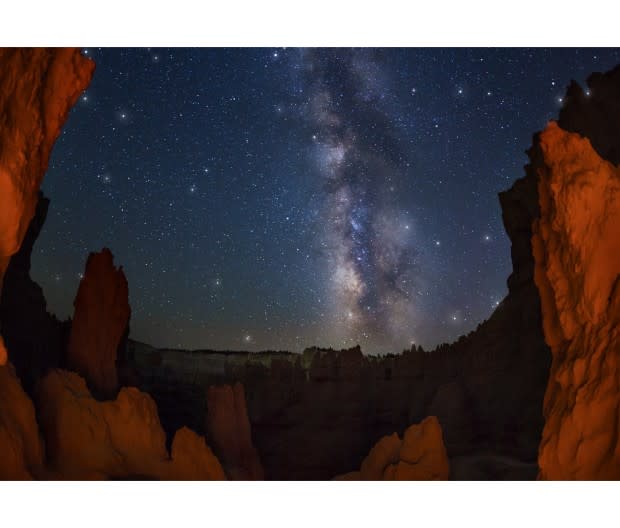
John Hicks
What to Do in Bryce Canyon National Park
Hiking is king along Bryce Canyon's numerous circuitous trails, featuring unique and startling views of a landscape that local 19th-century pioneer Ebenezer Bryce (after whom the canyon is named) purportedly called “a helluva place to lose a cow.”
If you do nothing else here, visit Bryce Amphitheater—home to the greatest concentration of hoodoo spires on the planet. Shaped by seasonal rains and melting snow, the bowl-shaped area is truly otherworldly.
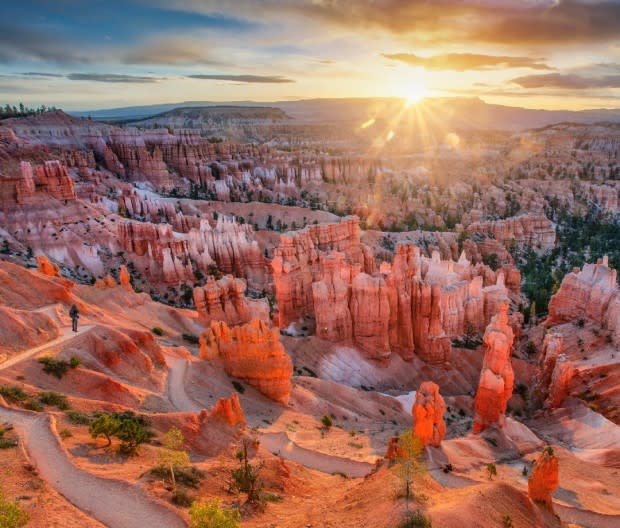
Getty Images/Nico De Pasquale Photography
Take in Bryce Canyon's trio of famed vistas—Inspiration, Sunset, and Sunrise Points—connected by either the Rim Trail or the first few miles of the park's main road—which carries on for another 15 miles along the Southern Scenic Overlook with several less crowded viewpoints ahead. Many of these spectacular overlooks also serve as trailheads for descending below the rim. Other modes of transport in the park include bicycles (along a shared-use path tracing the main park road) and viewing it all on horseback via nearly five miles of horse trails developed nearly a century ago.
However you experience the park, you’ll want to be here at sunset when the hoodoos are bathed in alpenglow. Stick around at night for premium stargazing in one of the few designated Gold Tier International Dark Sky Parks in the country.
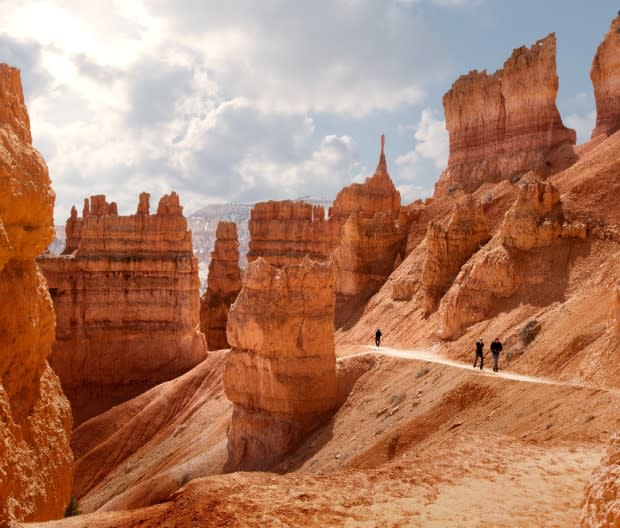
Getty Images/Ed Freeman
Best Bryce Canyon National Park Hikes
Located between Sunrise and Sunset point, 1.8-mile roundtrip Queen's Garden is the easiest trail descending from the rim into Bryce Amphitheater, and also one of the most spectacular. Hike it out-and-back to Queen Victoria hoodoo (total vertical: 450 feet), or combine it with the Navajo Loop to create a nearly three-mile round trip that descends at Sunrise Point and climbs back up at Sunset Point.
Whichever route you take, expect switchbacks winding between towering walls of colorful limestone lined by Douglas fir, as well as a meeting with the park's most famous hoodoo, Thor's Hammer. Tip: If combining the two trails, hike the loop counter-clockwise for less hiker traffic and to avoid a steep incline at the end.
The best way to access hiking trails, overlooks, and other attractions throughout Bryce Canyon is on the park's free shuttle, which operates from April to mid-October with stops every 15 minutes. Board before you enter at the shuttle station (Stop 1) or the visitor center (Stop 6). If you’re planning a hike, the shuttle service provides access to most major trailheads as well as scenic one-way hikes along Bryce Amphitheater Rim Trail.
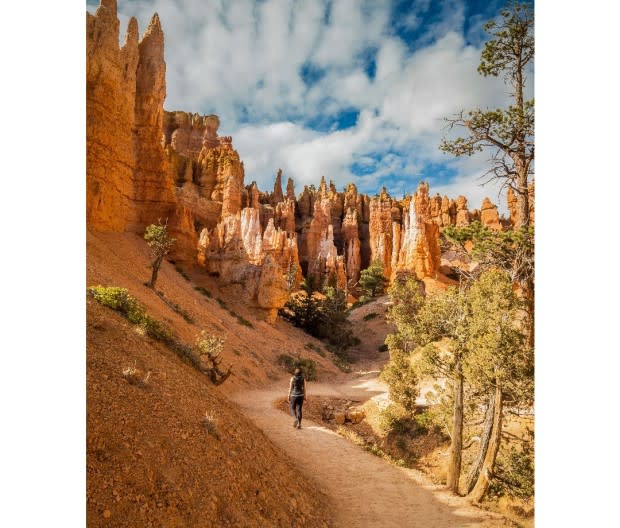
Getty Images/bmswanson
How to Get to Bryce Canyon National Park
If you're flying to Bryce, the closest airport is in Cedar City, UT, about 90 miles away. From either Las Vegas or Salt Lake City, it’s about a four-hour drive via I-15 to Exit 95 onto UT-20 E. Take that east to US-89 South then to Hwy 12. If you have the time, detour onto National Scenic Byway 143 and/or Hwy 12 (Utah's All-American Road) to traverse more awe-inspiring terrain—or tie in a trip to or from Zion National Park.
Where to Stay in Bryce Canyon National Park
Perched right next to the park on a high, pine-forested plateau overlooking the canyon, Bryce View Lodge is the best option for some pampering with your hoodoo viewing. A park shuttle stop is located on-site for easy park access—and the Western ambience here is an instant charmer, right down to the vintage barbecue dinner at Ebenezer’s Barn & Grill, featuring live music from Bar G Wranglers.
Related: Book a Jaw-Dropping Stay at These National Park Lodges in America
The park has two campgrounds, North and Sunset, located near the visitor center and Bryce Amphitheater, respectively. Sunset is a seasonal campground that’s closed during the winter. Between April and mid-October, campers are encouraged to use the park’s free shuttle to reduce traffic congestion.
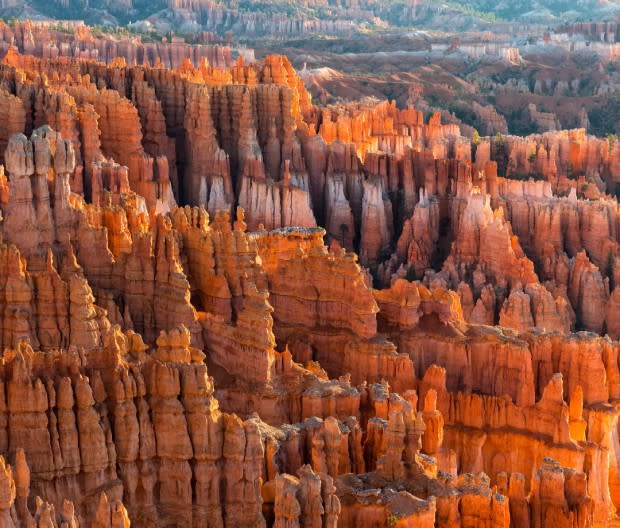
Getty Images/Westend61
Best Guide Services in Bryce Canyon National Park
Wildland Trekking offers single- and multi-day hiking tours of Bryce, as well as other options combining it with hiking tours in Zion National Park, Grand-Staircase Escalante National Monument, and other surrounding gems. Another option: Hire a private tour with a local guide from ToursByLocals.
